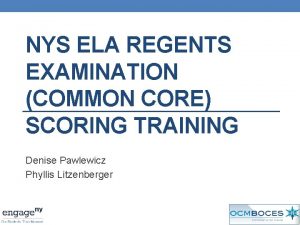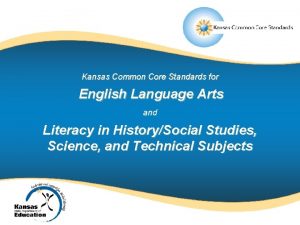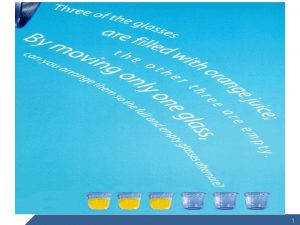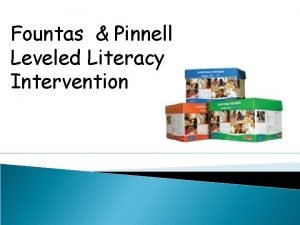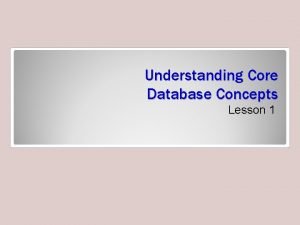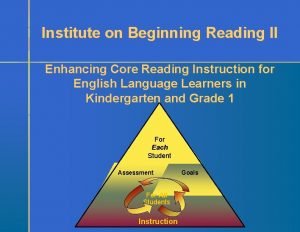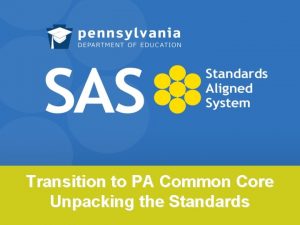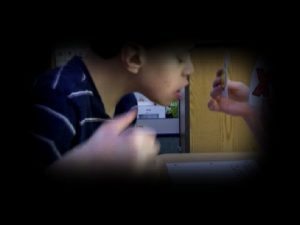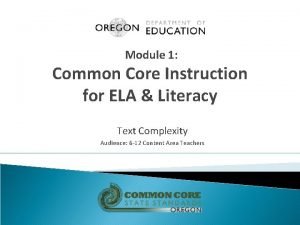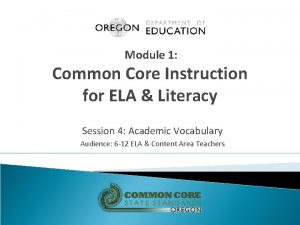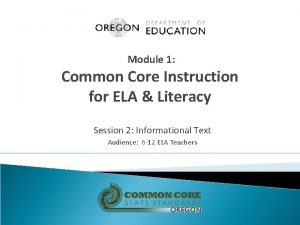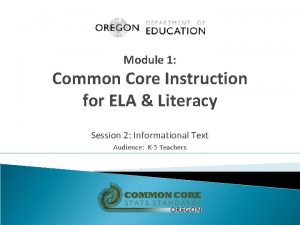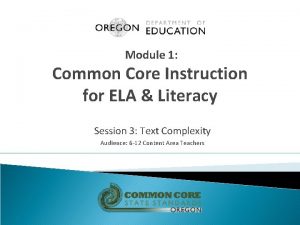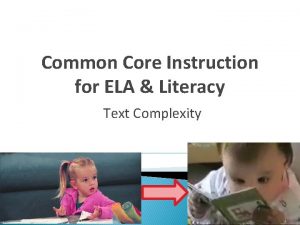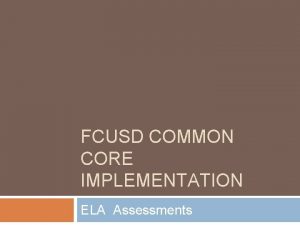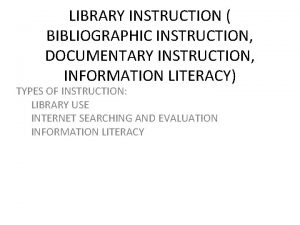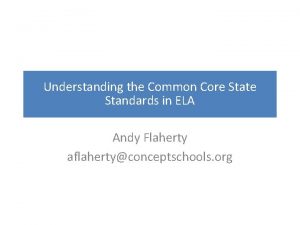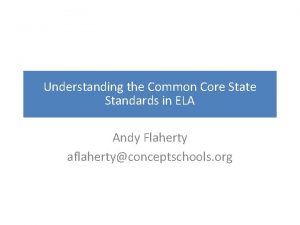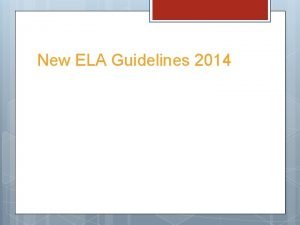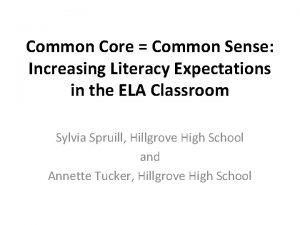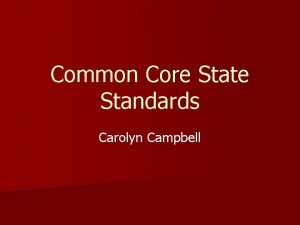Common Core Instruction for ELA Literacy Understanding the


















- Slides: 18

Common Core Instruction for ELA & Literacy Understanding the Organization Audience: K-5 Teachers

Expected outcomes Understand that the College and Career Readiness (CCR) Anchor Standards ◦ Define cross-disciplinary literacy expectations needed for students to enter college and workforce training programs; ◦ Provide the organizational “backbone” of the grade-specific Common Core State Standards (CCSS) for English Language Arts (ELA) and Literacy in History/Social Studies, Science, and Technical Subjects, except for the Foundational Skills; ◦ Are organized into four strands with subheadings under each; ◦ Depict an integrated model of literacy. Understand that grade specific CCSS ◦ Describe what all students should know and be able to do at the end of each grade or grade band. 2

CCSS: The big picture Common Core State Standards K-12 Mathematics K-5 English Language Arts K-12 ELA/Literacy 6 -12 History/ Social Studies Appendices A, B, C Science & Technical Subjects 3

CCR ELA/Literacy strands College and Career Readiness (CCR) Anchor Standards are divided into four interrelated literacy strands. College & Career Readiness Anchor Standards Reading Writing Speaking & Listening Language 4

Subheadings divide the CCR strands. The CCRs in each literacy strand are grouped into sections by subheadings. For example, Reading Key Ideas and Details Craft and Structure Integration of Knowledge and Ideas Range of Reading & Level of Text Complexity 5

Activity: CCRs in Reading Read through the CCR standards for READING under each subheading. In groups, discuss how the standards under each subheading are related. How are they distinct from those under other subheadings? Jot down phrases to describe the relationships or distinctions. 6

Other CCR strands, subheadings Writing ◦ ◦ Text Types and Purposes Production and Distribution of Writing Research to Build and Present Knowledge Range of Writing Speaking and Listening ◦ Comprehension and Collaboration ◦ Presentation of Knowledge and Ideas Language ◦ Conventions of Standard English ◦ Knowledge of Language ◦ Vocabulary Acquisition and Use 7

An integrated model of literacy “Although the Standards are divided into Reading, Writing, Speaking and Listening, and Language strands for conceptual clarity, the processes of communication are closely connected, as reflected throughout the CCR and CCSS documents. ” 8

Activity: An integrated model of literacy Take a minute to read through the CCR anchor standards of the Writing, Speaking and Listening, and Language strands. In groups, highlight or mark the CCR anchor standards in Writing, Speaking and Listening, and Language that are closely connected to the Reading CCRs. 9

Activity: An integrated model of literacy What interrelationships did you notice with the Language strand? Others? Research and media skills are blended into the Standards as a whole. Find examples throughout the strands. 10

Grade-specific Standards Describe what all students should know and be able to do at the end of each grade or grade band. ◦ Grade level standards at each grade K - 8 ◦ Grade band standards at high school: 9 -10 and 11 -12 Using a “back-mapping” design, grade-specific K-12 CCSS translate the aims of the CCR anchor standards into age- and attainment-appropriate terms. At the K-5 level only, an additional set of Foundational Skills are included in the Reading Standards. 11

ELA/Literacy CCSS Strands K-5 ELA History/SS Science & Tech Subj 6 -12 ELA Reading • Foundational Skills • Literature • Informational Text Writing Speaking & Listening Language 6 -12 History/SS Reading • Informational Text Writing 6 -12 Science & Technical Subjects Reading • Informational Text Writing 12

CCRs provide a parallel “backbone” Reading strand example CCR READING K-5 ELA & History/SS Science & Tech 6 -12 ELA 6 -12 History/SS 6 -12 Science & Technical Subj Key Ideas & Details 1. 2. 3. Craft & Structure 4. 5. 6. Integration of Knowledge & Ideas 7. 8. 9. Range of Reading & Level of Text Complexity 10. 13

Example of “back mapping” design Reading CCR #5: Analyze the structure of texts, including how specific sentences, paragraphs, and larger portions of the text … relate to each other and the whole. 9 -10. RI. 5: Analyze in detail how an author’s ideas or claims are developed and refined by particular sentences, paragraphs, or larger portions of a text …. 6 -8. H. 5: (History/Social Studies) Describe how a text presents information (e. g. , sequentially, comparatively, causally). 4. RI. 5: Describe the overall structure (e. g. , chronology, comparison, cause/effect, problem/solution) of events, ideas, concepts, or information in a text or part of a text. K. RI. 5: Identify the front cover, back cover, and title page of a book. 14

K-5 Foundational Skills 1. 2. 3. 4. Print Concepts Phonological Awareness Phonics & Word Recognition Fluency Grade Levels K 1 K 1 2 3 4 5 15

Activity: Grade-specific standards Examine the Common Core State Standards at your own grade level ◦ Compare the Reading Literature standards with the Reading Informational Text standards. ◦ Find connections among the Reading standards and those in the other three strands. How might teachers at your level integrate standards from two or more strands into small units or complex tasks? 16

How did we do? Decode the alphabet soup. ◦ ELA, RL/RI/RF, CCSS, CCR How are the CCR and the grade-specific Common Core State Standards related? Different? Recall the four strands in the Common Core State Standards for English Language Arts & Literacy in the content areas. Briefly explain how one Language standard could be integrated into a reading, writing, or speaking/ listening task. 17

What’s next? “What” & “how” The Common Core State Standards define what all students are expected to know and be able to do. The Oregon Literacy Plan addresses in detail how comprehensive reading programs can support student success. ◦ Subsequent sessions will address instructional implications of the CCSS for Oregon teachers and highlight resources in K-12 Teachers: Building Comprehension in the Common Core. ◦ Sneak a peek: “Using an Integrated Model of Literacy” classroom snapshots, p R-39 to R-46 http: //www. ode. state. or. us/teachlearn/subjects/elarts/readin g/literacy/have-you-ever. pdf 18
 Ela regents text analysis
Ela regents text analysis Common core reading
Common core reading Common core ela assessments
Common core ela assessments Achievethecore.org
Achievethecore.org Comparison of media literacy and information literacy
Comparison of media literacy and information literacy Arniel ping/media-and-information-literacy-communication
Arniel ping/media-and-information-literacy-communication Limitation of people in media
Limitation of people in media Cyber literacy and digital literacy
Cyber literacy and digital literacy Leveled literacy instruction
Leveled literacy instruction Individualized instruction vs differentiated instruction
Individualized instruction vs differentiated instruction Direct instruction method
Direct instruction method Core database concepts
Core database concepts Enhanced core reading instruction
Enhanced core reading instruction The brittle, rocky outer layer of earth
The brittle, rocky outer layer of earth Crust earth definition
Crust earth definition Which layer is the least dense
Which layer is the least dense Purpose of paradox
Purpose of paradox Common core state standards pa
Common core state standards pa Essential elements of state
Essential elements of state
